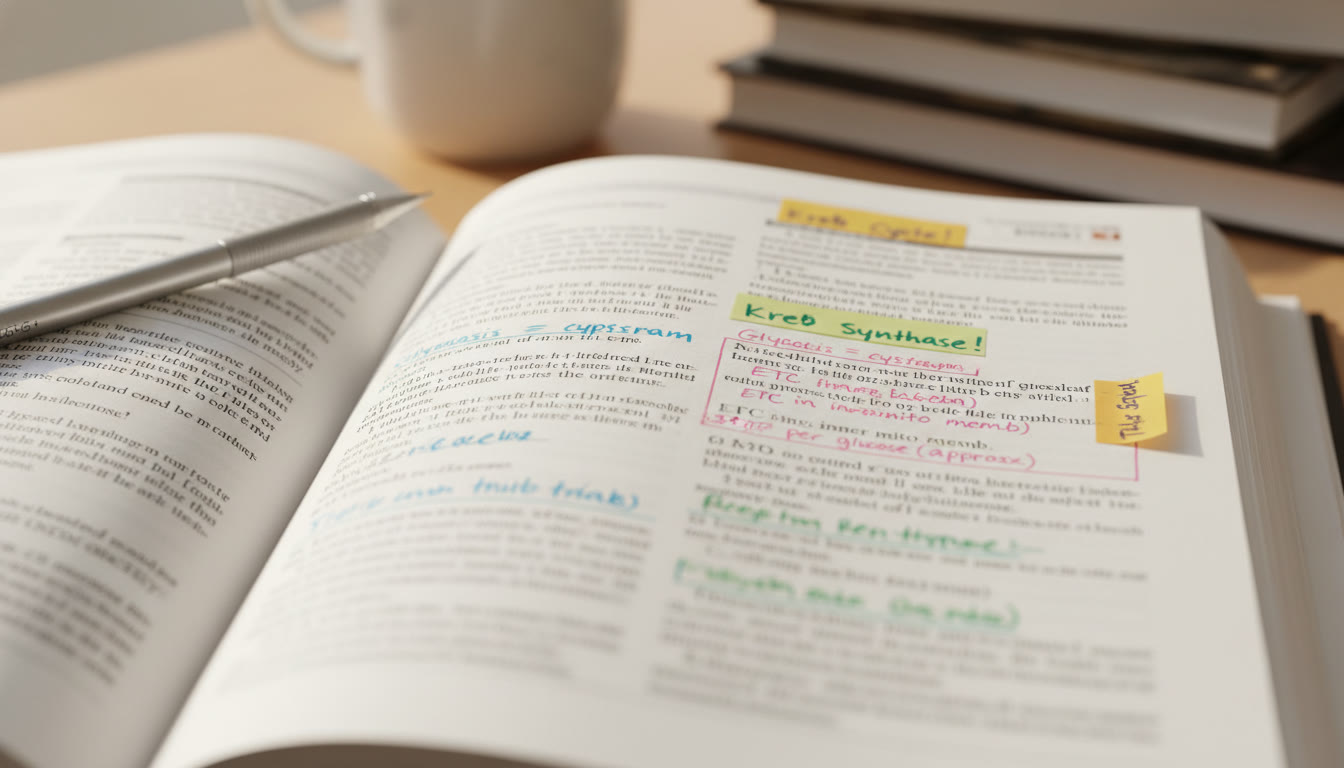Margin Notes That Help, Not Hurt
There’s a quiet power in the little blank spaces beside your textbook paragraphs. Those margins—often scribbled with half-formed thoughts, frantic abbreviations, or doodles—can either become a treasure trove of quick memory cues or a distraction that hides the true meaning of the text. For AP students juggling dense course content, higher-level thinking, and limited study time, turning margin notes into a purposeful tool is one of the smartest moves you can make.

Why Margin Notes Matter for AP Students
AP courses are built to be challenging: they combine college-level content with the expectation that you’ll synthesize, analyze, and apply. Margin notes do the heavy lifting when you use them intentionally. They:
- condense complex ideas into bite-sized reminders;
- create retrieval cues to speed up later studying;
- help you track questions you need to ask in class or during office hours;
- offer a quick map of a chapter when you’re reviewing for finals or an AP exam.
But not all margin notes are created equal. A messy margin can become cluttered noise. The goal is to design margin notes that enhance understanding and make revision efficient—so you spend less time re-reading and more time thinking.
Principles of Margin Notes That Actually Help
1. Purpose Before Pen
Before you write anything, ask: Why am I making this note? The most useful margin notes are made with one of a few clear purposes in mind: to summarize, to question, to connect, or to flag. If a note doesn’t meet one of those purposes, consider skipping it or saving it elsewhere (like a digital note or study app).
2. Keep It Short and Actionable
Margins are tiny. Treat each note like an index card—concise and actionable. Instead of rewriting paragraphs, capture the essence in a phrase, a symbol, or a mnemonic. For example, instead of copying an entire definition, write the key trigger word and a 2–3 word cue that will bring the full idea back to mind.
3. Use Consistent Symbols and Color
Consistency is what turns random scrawl into an efficient system. Choose a set of symbols and colors and use them the same way every time. Examples:
- ★ Important concept
- ? Question or unclear
- → Link to other topic or prior knowledge
- ⚑ Likely AP exam topic
Color coding can be simple: one color for definitions, another for examples, and a third for questions. Even two colors—one for content, one for questions—are better than none.
4. Prioritize Retrieval Over Transcription
Margin notes should help you retrieve information, not just store it. Use prompts that trigger recall: write a question you can answer from memory, or a partial formula that requires you to finish it mentally. When you review, cover the main text and try to answer the prompt in the margin.
Practical Margin-Note Techniques for AP Subjects
Different AP subjects require different note habits. Below are targeted approaches you can adapt.
AP Biology and AP Chemistry: Concepts and Mechanisms
Science margins should emphasize mechanisms, variables, and exceptions.
- Use arrows to trace cause-and-effect relationships.
- Write quick reminders of units or experimental controls (e.g., “ctrl: pH 7”).
- Flag counterexamples or conditions where a rule doesn’t apply—these often become free-response material.
AP Calculus and AP Statistics: Problem Threads
Math margins should act like a mini-solution roadmap.
- Sketch the first step or the substitution idea, not the whole solution.
- Write domain restrictions or special-case reminders near formulas.
- Use a box or underline for the final formula you need to recall under time pressure.
AP History and AP Government: Evidence and Argument
Humanities margins should support argument building.
- Summarize the paragraph’s claim in three words and note one piece of evidence you’d use to support it in an essay.
- Write contrasting perspectives in the margin—these form the backbone of comparison questions.
- Tag dates and names with a short note on significance, not biography.
AP English and AP Language: Tone, Strategy, and Rhetoric
For literature and rhetoric, your margin notes are tiny literary analyses.
- Label rhetorical devices (e.g., “anaphora”) and note the effect (“builds urgency”).
- Summarize character motivation in one line opposite key actions.
- Write potential thesis sentences inspired by the paragraph.
How to Structure Your Margin System
Creating a repeatable system is the trick. Here’s a suggested layout that balances clarity with speed.
| Margin Zone | Function | Example |
|---|---|---|
| Immediate Margin (closest to text) | Quick cues & definitions | “ATP = energy shuttle” |
| Outer Margin | Questions, connections, exam flags | “? Why X increases when Y decreases — ask teacher” |
| Top Margin | Section summary / thesis | “Main idea: Evolution via selection pressures” |
| Bottom Margin | Mini-summary for review | “3-sentence recap for quick review” |
This three-tier approach helps you glance at a page and immediately know where to look depending on whether you need a quick fact, a deeper connection, or a running summary.
Timing: When to Write Margin Notes
Not every read-through should become a margin-fest. Use timing to maximize efficiency.
- First read: Skim with light flags—stars for important sections, question marks for confusing parts.
- Second read: Add concise summaries and retrieval prompts.
- Problem or application session: Add examples, step cues, and error notes (what trips you up).
- Final review before exams: Turn margin questions into flashcards or quick oral prompts.
Digital vs. Paper Margins: Choose What Fits You
Both formats have strengths. Physical margins let you interact with the page—scribbling, circling, and physically flipping helps memory. Digital margins (in PDF readers or apps) allow search, hyperlinks, and reorganization. The smartest strategy often mixes both: keep paper for classroom reading and initial comprehension; use digital notes to compile and reorganize for intensive review.
Turn Margin Notes Into High-Speed Review Tools
Margin notes shouldn’t be the endpoint. They’re the raw material for active study. Here are practical ways to turn them into study gold:
- Weekly mini-reviews: spend 10 minutes per chapter turning margin prompts into 4–6 flashcards.
- Exam drills: cover the main text and answer the margin question aloud—time yourself for fluency.
- Peer swap: exchange margin prompts with a study partner to see whether your cues make sense to others.
Common Margin-Note Mistakes and How to Fix Them
Mistake: Overwriting
Students often rewrite entire passages into margins. This is inefficient. Fix it: write a one-line summary and a retrieval cue. Practice condensing a paragraph into a 10–12 word prompt.
Mistake: Too Many Colors and No Consistency
Color chaos looks pretty but slows you down. Fix it: limit yourself to two or three colors and keep a key in the front of your notebook or a consistent legend in your phone.
Mistake: Margin Notes That Only Restate
If your margin only restates the sentence next to it, you’re not adding value. Fix it: ask a question that requires synthesis or a quick example that applies the idea.
Real-World Example: How One Page Became a Review Machine
Imagine a page in an AP Biology chapter on cellular respiration. A raw read might leave you with dense paragraphs and a long list of enzymes. Apply purpose-driven margin notes and your page becomes a study sprint:
- Immediate margin: “Glycolysis: 2 ATP net, cytosol” (fact cue)
- Outer margin: “? Where does NADH donate electrons in anaerobic conditions?” (question to test later)
- Top margin: “Main idea: Energy extraction via redox steps → ATP” (section thesis)
- Bottom margin: “Quick recall: Glycolysis → Pyruvate → Krebs → ETC (34 ATP)” (review chain)
When you study, cover the printed paragraph and try to unfold the full mechanism from the cues. If you get stuck, the question in the outer margin points you back to a targeted spot to re-read—not the whole chapter.
Using Margin Notes for AP Exams: Tactical Moves
AP exams reward efficient recall, precision, and argumentation. Margin notes prepared with the exam in mind will save precious time.
- Flag potential FRQ (Free Response Question) evidence with a symbol—later, you can compile these into a mini-evidence bank for timed writing practice.
- Turn margin questions into practice prompts you can answer in the margin within two minutes—simulate exam timing.
- Mark likely multiple-choice trap areas with a caution symbol so you don’t second-guess yourself on test day.
How To Integrate Margin Notes with a Study Plan
Margin notes become most powerful when they connect to a broader study plan. A simple weekly routine could look like this:
| Day | Action | Time |
|---|---|---|
| Monday | Annotate new reading—light flags and 3 retrieval cues | 30–45 min |
| Wednesday | Convert margin questions into 10 flashcards; quick recall practice | 20–30 min |
| Saturday | Timed practice: answer three margin prompts in 10 minutes each | 45–60 min |
Repeat weekly and scale up as exams approach. This rhythm ensures margin notes are living tools rather than dusty scribbles.
When to Ask for Help: Turning Confusion Into Clarity
One of the best uses of margin questions is to track what you don’t understand. If a pattern of “?” marks appears across chapters, it’s a signal that you should seek targeted help—don’t let the confusion snowball.
Sparkl’s personalized tutoring can be especially useful here: a tutor can review your annotated pages, identify recurring gaps, and help you convert confusing margin questions into clear, answerable prompts. The benefit of 1-on-1 guidance is that an expert tutor sees patterns you might miss and creates a tailored study plan to address them. If you prefer tech-driven support, Sparkl’s AI-driven insights can help highlight weak spots quickly so your sessions focus on the highest-impact content.
Keeping Your Margins Clean Over a Long Course
Over a semester, pages fill up. Periodically clean up by creating a “Margin Harvest”—a short session where you:
- transfer recurring cues into a single review sheet;
- rewrite messy or illegible notes into clarified prompts;
- discard duplicate or irrelevant scribbles.
This small investment pays off when finals and AP exams loom: you’ll have a curated set of high-yield cues rather than a mountain of haphazard notes.
Examples of Margin Prompts That Work
Practice makes perfect. Here are concrete, copy-ready prompts you can use or adapt:
- “Explain in 30 seconds: How does X cause Y?”
- “List 2 exceptions to this rule and why they matter.”
- “Example: Apply this concept to modern-day situation A.”
- “Essay hook: How could this idea open a synthesis question?”
Measuring the Impact: Simple Metrics
How do you know if your margin strategy works? Use these lightweight metrics:
- Recall accuracy: cover the text and answer margin prompts—track correct responses out of 10.
- Speed: time how long it takes to reconstruct a paragraph’s main idea from its margin cue.
- Confidence: note how confident you feel answering a margin question on a scale of 1–5; watch this number grow with practice.
These tell you more than volume of notes; they measure learning.
Final Thought: Make the Margins Yours
Margins are personal. What matters most is a system you can repeat under pressure. Start simple: choose two symbols, one color rule, and one retrieval prompt style. Build from there. Over time, your margin notes will become a signature study shorthand—one that saves time, reduces anxiety, and helps you show up on exam day with clarity.

And remember: if you want targeted support turning your margin system into a high-yield study routine, Sparkl’s personalized tutoring offers 1-on-1 guidance, tailored study plans, and expert tutors who can help you translate confusing “?” marks into confident answers. Combine smart margin habits with thoughtful coaching and you’ll be surprised how much faster you can progress.
Margins are small real estate—but used well, they become the scaffolding for big ideas. Start today: pick one chapter, create purposeful margin notes, and measure how much faster you learn the next time you review. Little margins, big returns.
Quick Checklist: Start Your Margin Habit Right Now
- Pick 2 symbols and 2 colors and stick with them for a week.
- On your next read: add one retrieval question and one one-line summary per section.
- Once a week: convert margin questions into 10 flashcards.
- If confusion persists: schedule a short Sparkl session to get targeted help and a tailored study plan.
Good margins won’t do the work for you, but they’ll make your study time smarter, sharper, and more sustainable—exactly what AP success is all about.























No Comments
Leave a comment Cancel